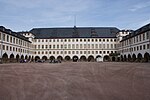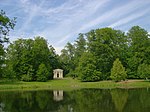Gotha (German: [ˈɡoːtaː]) is the fifth-largest city in Thuringia, Germany, 20 kilometres (12 miles) west of Erfurt and 25 km (16 miles) east of Eisenach with a population of 44,000. The city is the capital of the district of Gotha and was also a residence of the Ernestine Wettins from 1640 until the end of monarchy in Germany in 1918. The House of Saxe-Coburg and Gotha originating here spawned many European rulers, including the royal houses of the United Kingdom, Belgium, Portugal (until 1910) and Bulgaria (until 1946).
In the Middle Ages, Gotha was a rich trading town on the trade route Via Regia and between 1650 and 1850, Gotha saw a cultural heyday as a centre of sciences and arts, fostered by the dukes of Saxe-Gotha. The first duke, Ernest the Pious, was famous for his wise rule. In the 18th century, the Almanach de Gotha was first published in the city. The publisher Justus Perthes and the encyclopedist Joseph Meyer made Gotha a leading centre of German publishing around 1800. In the early 19th century, Gotha was a birthplace of the German insurance business. The SPD was founded in Gotha in 1875 by merging two predecessors. In that period Gotha became an industrial centre, with companies such as the Gothaer Waggonfabrik, a producer of trams and later aeroplanes.
The main sights of Gotha are the early-modern Friedenstein Castle, one of the largest Renaissance Baroque castles in Germany, the medieval city centre and the Gründerzeit buildings of 19th-century commercial boom.
Gotha lies in the southern part of the Thuringian Basin in a flat and agricultural landscape.











